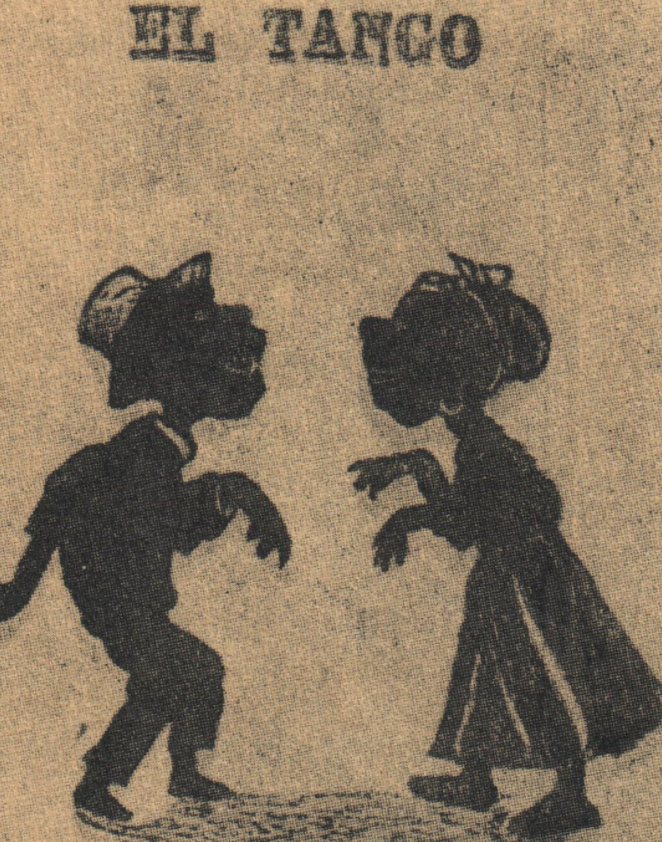The Lunfardo is the jargon of tango, it has the structure of the Spanish language with mixed lexicon (words) of other languages such as Italian, Polish, Portuguese, French. It also includes the ‘vesre’ , a way of speaking by reversing the syllables of the words. For instance if you would like to say “libro” (book), you would say “broli”.
Read MoreIn the early 2000s, I ran into Ramiro Gigliotti at Salon Canning. I had met him a couple of years earlier when he came to teach in L.A. I loved his dancing, and he was very kind to me. I was already teaching in LA, and I was always looking for ways to get better in Argentine Tango.
Read MoreWords to describe the Tango of the beginning of the XX century:
Quebradón, Compadrón, Dislocador, Onduloso (curvy), Mimoso (cuddly), Voluptuoso (voluptuous), De vaivén (with swing), Marcadísimo (marking the beat), Triste y candecioso (sad and with cadence)
Carmencita’s significance as a tango dancer:
* She had 87+ years of tango dancing.
* She danced and performed with El Cachafaz one of the most important male Tango dancers.
* She performed in the first Argentinean sound movie “Tango” in 1933.
* Her dance was unique, musical. She improvised and interpreted beautifully the lead of her partner with adornments.
* Carmencita and El Cachafaz created a new tango dancing style with corridas - sentadas - quebradas (Anecdotally she also says that she is the creator of the tango skirt slit)
Read MoreFor the dancers, Carlos Di Sarli brings us lots of memories. Maybe the first class taken was playing his music. I particularly remember a performance of Osvaldo Zotto and Lorena Ermocida of Bahía Blanca at el Club Almagro in the 90s. I thought they were magnificent, and I will never forget how they expressed the music of Di Sarli with their foot work and embrace.
Carlos Di Sarli has many danceable tangos . They are simple, with a clear beat and at the same time the violins add a great sweet romantic melody. The piano is present in all the little spaces, to give us followers the opportunity to add embellishments. The almost inexistent bandoneon, appears in the moments that it is needed, given to the piece the tango flavor.
Read MoreAccording to himself: “I left the (Troilo’s) orchestra around 1949 - I had an attack of erudite music - and it was then when Piazzolla erudite was born. I composed symphonic music, chamber music. The orchestra of Bruno Bandini of Radio Del Estado would play everything I wrote,, everybody was playing my music, so I started feeling superior. I didn’t want to go back to tango. But I needed to pay bills so I created arrangements for Troilo, Pugliese, Fresedo.
In 1953 my maestro Ginastera suggested to enter to a competition to study with Nadia Boulanger in France Boulanger. I won. I felt I was Beethoven. (…) I learned everything I know. I discovered Piazzolla thru her. When I played Triunfal she took my hands and told me “this is you” (…) what I do is TANGO. You can find Gobbi, De Caro in my music.
Read MoreMy favorite pieces
Gitana rusa, 1942, Orlando Medina
Embrujamiento, 1942, Orlando Medina
Ninguna, 1942, Orlando Medina
Remembranza, 1943, Orlando Medina
Madgalena, 1943, Orlando Medina
La piba de los jazmines, 1943, Orlando Medina
One of the first cabarets was called The Armenonville - located at the Plaza Grand Bourg, in an European style chalet. In 1913 they called for auditions and Robert Firpo was selected among many other musicians. It is the beginning of the PIANO as the leading instrument in tango. The famous duo Gardel- Razzano also premiered there in 1913 while Firpo was playing.
Read MoreMy favorites tunes of Rodolfo Biagi
Gólgota, 1938, Teófilo Ibañez
El trece, 1938 -
Griseta, 1939, Andrés Falgás
Cielo, 1939, Andrés Falgás
Read MoreI love dancing to the orchestra of Francisco Lomuto. They played very danceable songs, with a strong rhythm structure and catchy melody structure. He was influenced by his friend Francisco Canaro, who helped him out at the beginning of his career.
Read MoreAs many of you know, the orchestra of Ricardo Tanturi is my favorite, especially with singer Alberto Castillo. Así se baila el tango is my mother's favorite tango, and she always treasures her memory of seeing Alberto Castillo at the break of her concert standing next to the Club Andes Talleres Club Sport in Godoy Cruz, Mendoza where she used to live at that time…
Read MoreIn his own words: “I am a milonguero (tango dancer) (…) so I shaped my orchestras with two conceptions that I never gave up: respect for the melodic line and rhythmic emphasis to make the dancing easier. When the singer breaks into the scene and displaces the musician from the spotlight, the orchestra was structured in such a way that music and singing did not interrupt the possibility of dancing. For that, the singer had to turn into one more instrument, a privileged instrument, but not apart.”
Read MoreSome of the women that made history in the Tango of the beginning of the 20th century
Carmencita Calderón - DANCER (1902-2005)
Ada Falcón - SINGER (1905-2002)
Paquita Bernardo - BANDONEONIST (1900-1925)
Nelly Omar - SINGER (1911-2013)
Pepita Avellaneda - SINGER (1874-1951)
Tita Merello SINGER (1904-2002)
Libertad Lamarque - SINGER (1908-2000)
Read MorePlayed with Julio De Caro’s orchestra and Pedro Maffia - the dos PEDROS dúo (two Pedros bandoneon duet). Maffia leaves in 1926. He wrote beautiful variations for Mala Junta (1947) and Mal de Amores. Pedro Laurenz created his own orchestra in 1934. He took with him from De Caro’s orchestra: Armando Blasco (bandoneón) and Osvaldo Pugliese (piano).
Read MoreWhile Gardel was an innovator for singing tango, De Caro was a vanguardist in the way he composed and play tango.
He, first of all, was one of the transitions to the GUARDIA NUEVA, adding sophistication and “yeites” to his compositions and performances. Future orchestra leaders such as Pedro Laurenz, Osvaldo Pugliese and Pedro Maffia passed through his orchestra. Pugliese, in particular would reach the heights he achieved by following the De Caro’s school.
Read MorePianist, leader and composer. (2 November 1910 - 31 March 1992)
He focused on the melody with a very simple rhythmic conception. His best numbers were those with vocal duos (Dante/Martel). Around 1949 the orchestra wen through a brief rhythmic period but the departure of Julio Martel at the end of 1951 marks the end of their best recording, with the exception of instrumentals (Pavadita).
Read MoreLucio Demare is born in 1906 in the neighborhood of El Abasto, in Buenos Aires, in a family of musicians. The father Domingo played the violin, his brother Lucas (important cineaste) the bandoneon, and Lucio chose the piano. At 8 he was already working playing to musicalize silent films in a cinema. He was the composer of Malena.
Read MoreBandoneonist active with own orchestras since the 20s, and recordings since 1933. Associated with the 40s. He was part of groups with Francisco Pracánico and Osvaldo Fresedo. But he created his own style. He was formally trained.
Read More"I always followed my way: a music with a clean melody, full of shades, well balanced between bandoneons and violins… I want to touch people with the melody, reach their heart, but softly. [...] The first thing I use to do, is to convince each musician until they feel for real what they are going to play." Osvaldo FRESEDO
Read MoreBandoneonist, composer and director (he also played violin)
His orchestra followed the influences of Edgardo Donato and Juan D’Arienzo. It was a revolutionary because in his Orchestra of all Rhythms he included all kinds of music:.(fox trox, polkas, valses, tangos, paso dobles and rancheras.)
Read More




















